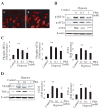Endoplasmic reticulum stress is implicated in retinal inflammation and diabetic retinopathy
- PMID: 19364508
- PMCID: PMC2691649
- DOI: 10.1016/j.febslet.2009.04.007
Endoplasmic reticulum stress is implicated in retinal inflammation and diabetic retinopathy
Abstract
Diabetic retinopathy is a chronic low-grade inflammatory disease; however, the mechanisms remain elusive. In the present study, we demonstrated that endoplasmic reticulum (ER) stress was activated in the retina in animal models of diabetes and oxygen-induced retinopathy (OIR). Induction of ER stress by tunicamycin resulted in significantly increased expression of inflammatory molecules in the retina. Inhibition of ER stress by chemical chaperone 4-phenyl butyric acid ameliorated inflammation in cultured human retinal endothelial cells exposed to hypoxia, and in the retinas of diabetic and OIR mice. These findings indicate that ER stress is a potential mediator of retinal inflammation in diabetic retinopathy.
Figures





References
-
- Frank RN. Diabetic retinopathy New England. Journal of Medicine. 2004;350:48–58. - PubMed
-
- Zhang SX, Wang JJ, Gao G, Shao C, Mott R, Ma J-x. Pigment epithelium-derived factor (PEDF) is an endogenous anti-inflammatory factor. FASEB J. 2006;20:323–325. - PubMed
-
- Mitamura Y, Takeuchi S, Matsuda A, Tagawa Y, Mizue Y, Nishihira J. Monocyte chemotactic protein-1 in the vitreous of patients with proliferative diabetic retinopathy. Ophthalmologica. 2001;215:415–418. - PubMed
Publication types
MeSH terms
Substances
Grants and funding
LinkOut - more resources
Full Text Sources
Other Literature Sources
Medical
Molecular Biology Databases

